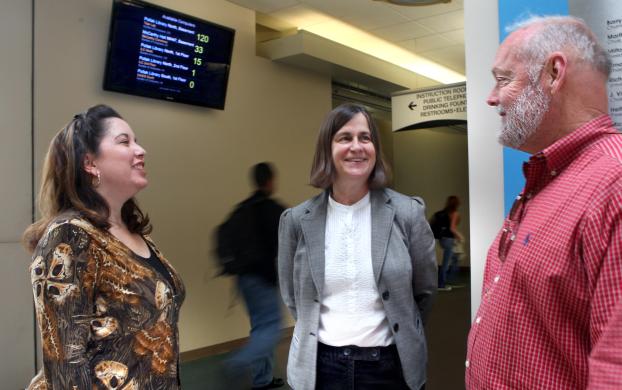 Caption: Colleen Greene, left, Elizabeth Housewright and Richard Pollard share a light moment in front of the reader board that keeps a tally of the available computers in various library locations and at McCarthy Commons in the basement of McCarthy Hall. Photo by Karen TapiaDownload Photo
Caption: Colleen Greene, left, Elizabeth Housewright and Richard Pollard share a light moment in front of the reader board that keeps a tally of the available computers in various library locations and at McCarthy Commons in the basement of McCarthy Hall. Photo by Karen TapiaDownload Photo
Cyber Learning Center
Pollak Library Evolving to Serve Today's Educational Needs
You can’t tell by walking past the Paulina June and George Pollak Library, but it is undergoing big changes. At the speed of electrons, it has left behind the traditional “Quiet, please!” library and is becoming a cyber learning center.
“The key is still education and the focus is always the students,” said Colleen Greene, systems librarian. “As part of our Web redesign, we want the Website even more intuitive and searches more seamless.”
Focus groups are used to keep the library on track, she added. To help searches along, the library creates research guides, which are bundles of related information. One search in a particular subject can bring up an entire bundle, she said, adding that faculty members help in formulating many of the guides.
Richard Pollard, university librarian, and all of the library staff track evolving student expectations for the library. Topping students’ list, surprisingly, is one that isn't very high-tech: They want computers and study areas constantly available.
“It’s a great place to study, a great atmosphere, and computers are available to check assignments and do research,” said Brittany Le, a sophomore pre-nursing student. Added Danielle McGee, a junior kinesiology student, “More and more research is required (for my assignments). It’s a great place for that.”
Students want as much as possible online. Tutorial videos are examples. One such video is an introduction to the reference desk and another a student-produced comedy tour of online library services, both posted on the library’s YouTube page. Tutorials supplement the 500 classroom sessions each year on using the library. “We also have instructional text and videos on using specialized search programs, such as Articles Widget,” said Elizabeth Housewright, associate university librarian.
Available Day or Night
Students also expect constant access.
“The library gets round-the-clock requests,” said Housewright. “Several libraries cooperate to cover the 24/7 chat reference service. We also post messages on our social media channels to let them know about events, new services, hours of operation and so forth. One tweet invited them to savor the air conditioning on hot days,” Housewright added.
Besides YouTube and Twitter, the home page offers Facebook, MySpace and Flickr. “We encourage faculty to use them, too, including for instruction,” she said.
Another technological advance began at Pollak and could spread across campus. “The library was a pilot in establishing SharePoint,” said Greene, who works with Information Technology to service the library’s evolving needs. SharePoint provides ‘one-stop shopping’ for creating Web pages, communicating, projects and the documents that go with them, databases and more, Greene explained, adding, “We’re using it for communications, collaborations, document sharing and meeting sites. It’s like our own intranet. It helps make the library a campus technology leader.”
More Publications, Less Space
More publications are becoming available electronically and Cal State Fullerton’s library is exploring how to take advantage of the evolving market, even in a tight budget period. One pilot project places electronic books in the library’s catalog of publications to borrow, but the library purchases only the publications patrons use. That way, patrons choose what they need and the library doesn’t have to buy what isn’t used.
Pollak has about 1.3 million print publications and about a fifth that many available only electronically, but that ratio is changing. With that change, more floor space opens.
“Gone are the days when we plan to fill the space with books,” said Housewright. “Instead, we will add more research, study and discussion areas, and share space with groups with similar needs. We’re working with University Advancement, the Center for Oral and Pubic History and the library’s Special Collections on possible designs that will accommodate things like special artifact storage. We’re also trying a lockable room for graduate students to leave books.
“The idea,” she said, “is to make the library as useful as possible to as many as possible.”
Oct. 4, 2010
